| |
Metallographic cross-sectioning is the process of exposing the
internal plane of interest of a sample for detailed examination. The process
consists of mounting, sawing, grinding, polishing, and etching the sample so
it can be analyzed using an optical microscope.
A scanning electron microscope may also be used to
verify and take a closer look at the microstructure that was observed under
an optical microscope.
|
|


|
|